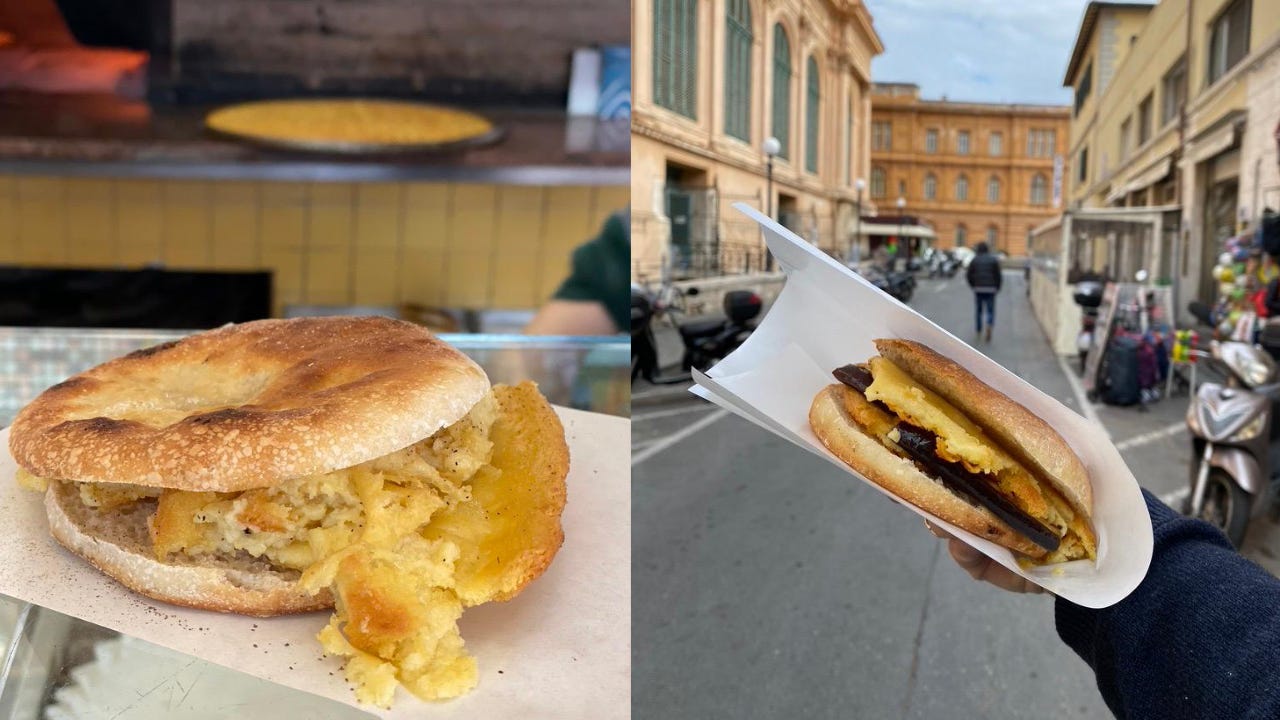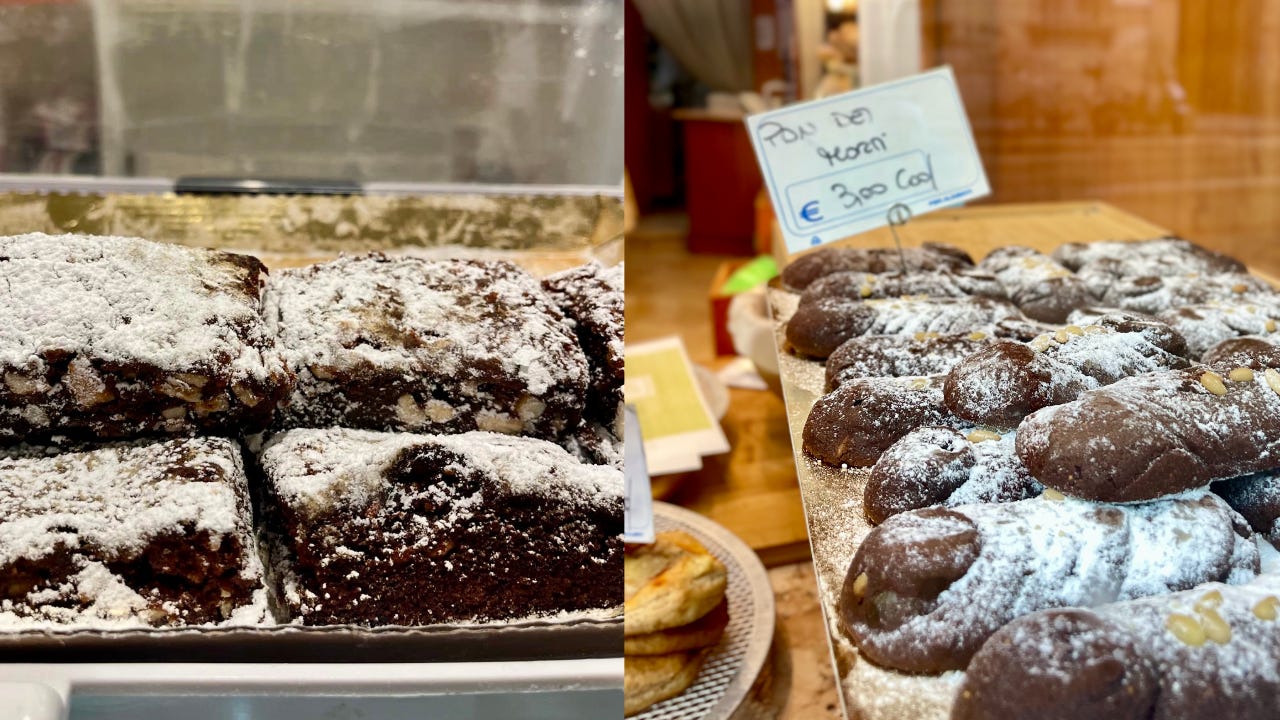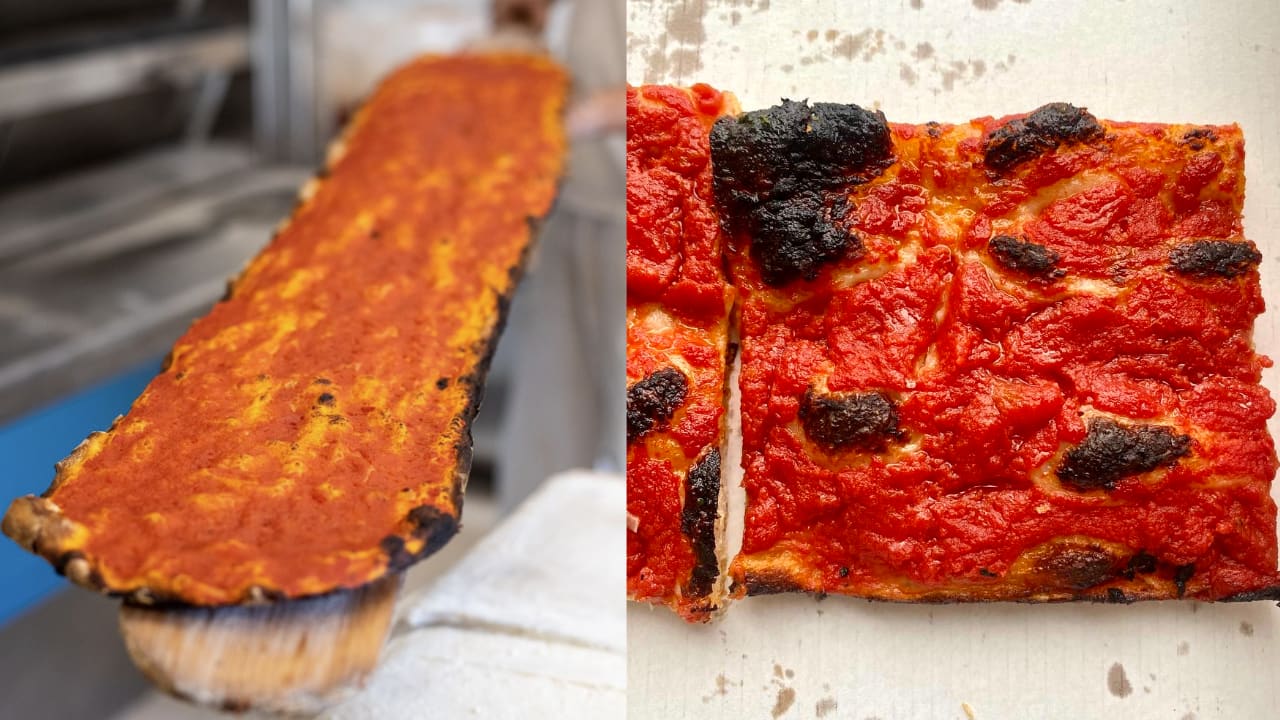The Bread Issue | Part 2
Two iconic bread-based products from Rome and Livorno respectively, plus a northern Italian bread made for the Day of the Dead
Welcome to our fresh new Cabinet of Curiosities, the source for your monthly food digest and discovery of all things curious about the world of Italian food culture!
This month we’re tackling a vast, gigantic and diverse subject: bread. Italy has enough bread types, recipes and shapes to fill an encyclopedia, so we’ll just take a small bite at it. We begin with an always lighthearted piece by Francesco: a deep dive into 5e5, Livorno’s specialty street food; followed by a timely story on Pan dei Morti by Ilaria, a traditional bread which is prepared in Lombardia during this time of the year. Lastly, prepare to drool with appetite at Flora’s quest for the perfect Roman pizza rossa.
Enjoy the read and let us know what you think in the comments below!
Give me 5…and 5!
by Francesco Pellegrini: wine lover, obsessed with NY cheesecake and nature photography fan.
Despite the title that evokes friendly situations, the food I am going to talk about must be treated with absolute seriousness.
We are faced with one of the cornerstones of Tuscan street food (on a par with lampredotto): the 5e5 – cinque e cinque! For those who don't know, 5e5 is the name locals in Livorno call a sandwich stuffed with baked chickpea flour “cake”.
The origin of the chickpea cake, very common in the upper Tyrrhenian area, has always been a topic of debate: in Genoa they call it farinata, in Pisa cecìna (NEVER use that name in Livorno, you will make enemies!) and torta in the city of 5e5. It is a dispute that would deserve a separate discussion, from which, in any case, we would hardly draw a definitive answer...
The idea of serving it in a sandwich is to be attributed entirely to Livornesi. The name was born around the 1930s when the price of bread and the “cake” were the same, five cents of a Lira. Thus the habit of asking bakers for “5 cents of bread and 5 cents of cake”, which became 5e5 in short.
Tradition dictates that the “cake” - made with chickpea flour, water, salt, seed oil all baked in a wood oven - should be served hot in a francesino (a bread roll without milk or lard) or in a schiacciata (crispy Tuscan focaccia) with a sprinkling of pepper.
The only variation allowed is the addition of melanzane sotto pesto, and accompanied with a glass of fizzy spuma bionda, an iconic Italian soft drink. Dé bimbi, è la morte sua!
The sandwich can be found all over the city, but my favourite 5e5 spot is Gagarin, a small baker without a sign, considered by many the best in Livorno. It’s the perfect dish for kids and adults, paired with spuma bionda or beer respectively, it’s cheap, gluten free and vegan – 5e5 might just be the most inclusive street food that ever existed.

Pan dei Morti: bread of the dead
By Ilaria Riva: Storyteller, on a hunt to find taste, history and natural beauty on less traveled paths around Italy.
Food offerings to honour the deceased are part of our customs since Ancient Roman and Greek times, a practice which evolved through the ages and blended with new customs and the influence of Catholic traditions.
Italy boasts a rich variety of regional customs, each with its unique take on commemorating the dead. In Puglia, it is common to prepare Grano dei Morti con Melograno, which literally means “Cooked Wheat of the Dead with Pomegranate”, where the wheat symbolizes life and rebirth, while pomegranate seeds represent fertility and the cycle of life.
In Umbria, locals enjoy almond-flavoured cookies known as Fave dei Morti, or “Broad Beans of the Dead”. In Sicily, as well as other regions, there are Ossa dei Morti, “Bones of the Dead”, simple biscuits made with flour and sugar. In Trentino Alto Adige, families make horse-shaped cookies (symbolizing strength and fidelity) called Cavalli, while in Naples, they prepare O’ Morticiello, or “Nougat of the Dead”.
Last but not least, in Lombardy, the “Bread of the Dead” is habitually baked, a custom that has also spread to parts of Liguria and Piedmont.
The Pane dei Morti, traditionally prepared in the days leading up to the Day of the Dead, is made with ingredients harvested and dried at the end of summer, such as figs, dried raisins, nuts and grains. Cocoa is a more recent addition that gives this baked good a rich, dark color reminiscent of the soil in burial grounds. Originally, honey and butter were browned gently on the stove to provide the desired dark shade. The cookies are dense and moist and the texture is complemented by pine nuts, which evoke the imagery of the bones of the departed.
In the past, farmers believed that the souls of the deceased returned to the homes they had once lived in on the night of November 1st, following the same pattern as agricultural work. To welcome these spirits, families would prepare a meal for them with the traditional Pane dei Morti as a tribute. The offerings served to honour their memories and invite them to be part of the warmth of the household once again. In this way, food became a link between generations, emphasizing the importance of remembrance.
Pizza Rossa Romana - the art of mastering simplicity
By Flora Igoe: Graciously greedy - Irish born, Italy based - human, with a knack for discovering good food.
My quest for the best pizza rossa romana has led me through many twists and turns of Rome. Some ventures have brought less satisfying results than others but only one so far, I would classify as negative. The fact of the matter is, I love pizza rossa. Its thin-based simplicity and Roman way of making the most of a few good ingredients – tomato, bread, oil – leads me to be more and more impressed by those who have perfected it.
First, there is the flavour, a perfect balance between sweet, tangy tomato and slightly charred dough, wood-fired by the best forni, or bakeries. Drizzled on top, olive oil draws these flavours together, smoothing them over and sometimes adding a subtle peppery depth. I could go on and on. Then, there is its very being. An unpretentious existence deeply tied to practicality – pizza rossa was supposedly used to test the heat of Roman bakers’ wood-fired ovens. When a perfect scrocchiarella, or crunchiness, was achieved, the oven began its pricier bakes. Cooked on large slabs and served al taglio, or by the slice, it continues to remain an affordable meal worthy enough of a snack, a light lunch and dinner, or let’s not forget, breakfast.
So much is pizza rossa’s ease on the pocket and, may I say, stomach, I have tried quite an array of Rome’s offerings. There are the eminent classics, take Roscioli or Campo de ‘Fiori – both forni which are over 200 years old - to the lesser known but equally impressive Albanesi, which has been baking pizza rossa for 65 years. After trekking wide and far, the best and really the very best I’ve found is Pantera. Unlike the others, Pantera has been open only since 2023, yet its respect for tradition and quality ingredients is what makes their pizza rossa, in essence, all it should be. A few good things: tomato, bread, oil – are sourced for their highest quality; Tomatoes from Agricola Marasca, flour from Molini Fagioli’s OIRZ range and extra virgin olive oil from Olio Flamminio.
As I savour a fresh slice at Pantera’s counter, co-founder Nicolò Trecastelli comments on how it’s harder to make a simple pasta than a complicated one, the same going for pizza - but it's safe to say they’ve mastered it.







👍🏻👍🏻👍🏻👍🏻👍🏻👍🏻👍🏻 Felice di leggere queste informazioni sul cibo italiano. Si impara ogni giorno!
Oh, this was the second issue, it was already out 😄